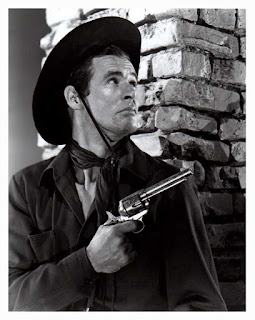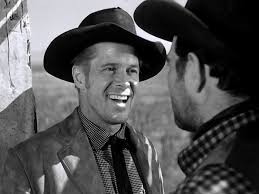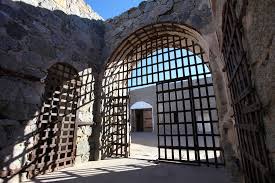Like many of the western writers
I’ve corresponded with, I didn’t get into westerns from reading the kind of
novels I’d eventually write. I was initially hooked by what I watched, on the
cinema and on TV, during my boyhood in the 1960s. And entering the world of the
screen western was like joining a family, peopled by familiar faces. Actors
re-occurred in the same roles – the same leading men, leading ladies,
‘sidekicks’, character actors and bit players (usually stunt men given an odd
line.)
But perhaps most enjoyable of all
were the villains.
Westerns are of course morality
plays and if the hero represented the best in people, they needed a foil, an
opponent, to represent the very worst; worthy opponents against whom the hero
has to be tested. They were often as enjoyable, and quite often more enjoyable,
than the heroes.
In my blog BEST OF THE BAD MEN #1 (Link here: https://andrewmcbrideauthor.blogspot.com/2017/10/best-of-bad-men-1.html ) I’ve already discussed many of the excellent actors who gave good villain in
westerns – but there were too many ‘good’ bad men for one blog to do them
justice. I felt the very best bad men deserved at least a blog of their own. So
here’s THE HATEFUL EIGHT - the very worst of the west. Some were quite easy to
pick, others I had to think about (and I’d probably change my mind about if I
was to do this blog again next week.)
So here’s villains ranked 2-8, in
no particular order:
RICHARD WIDMARK was an actor of
wide range and ability. He could be a hero as often as a villain. He played the
‘good guy’ in films like ‘The Last Wagon,’
and ‘Backlash.’ His most heroic role
was probably as Jim Bowie in ‘The Alamo’
(1960) a performance described by John Wayne – who directed it – as ‘magnificent.’
And he could play conflicted characters such as the outlaw who renounces his law-breaking
ways in ‘Warlock,’ or the obsessive
submarine commander in the powerful Cold War drama ‘The Bedford Incident.’
But much as I enjoyed these
performances, I always had a special fondness for Widmark the villain. His bad
guys always had a dangerous, seductive charm, whether he’s up against Gregory
Peck (‘Yellow Sky’) or Gary Cooper (‘Garden of Evil.’)
One of his best bad guy performances
is in ‘The Law and Jake Wade.’
There’s a great scene where Widmark talks to a U.S. cavalry officer. He’s pretending
to be an upright citizen, and exudes charm and reasonableness. When the officer
rides away, there’s a priceless moment when Widmark smiles after him; but once
he’s out of sight Widmark’s smile turns into a leer of pure evil.
Richard Widmark in ‘The Law and Jake Wade.’
ROBERT RYAN was another actor of
wide range who could sometimes portray characters of integrity and dignity –
but he was also a tremendous villain. In the masterful modern western ‘Bad Day at Black Rock’ he’s ostensibly a
pillar of the community. He’s an intelligent, charismatic figure and a natural
born leader – but he’s also poisoned by racism, in this case a hatred of the
Japanese, which turns him into a ruthless murderer.
Robert Ryan in ‘Bad Day at Black Rock.’
In ‘Return of the Bad Men’ there’s no such redeeming features – he’s just
irredeemably villainous and loving it! In an enjoyable but wildly unhistorical
western, he more or less steals the movie as The Sundance Kid - a snarling
psychopath who’s a long way from Robert Redford! The movie climaxes in a shoot
out in a ghost town between Ryan and Randolph Scott.
As The Sundance Kid in ‘Return of the Bad Men.’
In the superb ‘The Naked Spur’ Ryan plays a ‘laughing’
villain – he even laughs during a fight with Ralph Meeker, which indicates
someone teetering on the edge of irrational violence. Like a number of western
villains he has a girlfriend (in this case Janet Leigh) who believes him when he
says he’ll reform from his wicked ways. “Remember what you said.” she urges, to
which Ryan responds with a classic bad guy line: “I remember what suits me!” As
I’ve said, bad guys often had the best lines!
In ‘The Naked Spur.’
In the field of ‘laughing
villains’ none were better than DAN DURYEA. He played the bad guy in innumerable
western movies and TV shows, bracing the likes of James Stewart and Audie
Murphy. His long face, whining voice and most particularly his wild grin and
jangling laugh marked him out as dangerously unstable, a powder keg always
ready to blow. Perhaps his best performance in this vein is in the 1950 classic
‘Winchester 73.’
Dan Duryea in ‘Winchester 73’ (1950), a ‘laughing
villain’
And coming off worst against
James Stewart.
LEE VAN CLEEF spent years as a
snake-like side kick to other villains (‘High
Noon’ ‘The Man who shot Liberty
Valance’) before ascending to top-rank villainy in Spaghetti westerns like
‘The Good, the Bad and the Ugly.’ I’ve
always had my reservations about that title – Eli Wallach isn’t that unhandsome
in my view, and it’s a bit of a stretch to describe Clint Eastwood’s amoral
bounty hunter as strictly ‘good,’ but Van Cleef’s gleeful killer is definitely bad. In ‘Ride Lonesome’ Van Cleef commits one of the worst crimes of any western
bad guy – he hangs Randolph Scott’s wife. A crime for which he pays the usual
price, in the shadow of the hanging tree.
Lee Van Cleef in ‘Ride Lonesome.’
Some western villains will remain
famous for one role above all others. ELI WALLACH made relatively few westerns,
but will be long remembered as Calvera in ‘The
Magnificent Seven’ (1960.) As the leader of a rapacious band of Mexican
bandits, he’s more a tyrant with delusions of grandeur than mere self-serving
villain. In his own warped view, he’s simply maintaining the natural order of
things. And he gets to say one of the most memorable lines in western film. Regarding
the Mexican peons he feels he almost has a divine right to oppress, he
declares: “If God didn’t want them sheared, he would not have made them sheep.”
Eli Wallach in ‘The Magnificent Seven’ (1960.)
Another bad guy famous for one role
in particular is JACK PALANCE. In ‘Shane’
he’s the gunman hired by a cattle baron to terrorise Wyoming homesteaders. The lank,
gaunt Palance, with his cadaverous features and gloating smile, is the epitome
of evil – even dogs slink away from him. This blackest of black hats –
literally – lovingly pulls one glove – also black - onto his gun hand as he prepares
to despatch one of these pesky ‘sod-busters’. His victim is the pathetic but still
brave ‘little man’ Elisha Cook Jnr. who falls before his gun, jolting backwards
and ploughing into the mud of the street in the first ‘realistic’ depiction of
death in the history of the western. Even in an age of much more graphic
violence this scene still has the power to shock. And viewing the victim of his
murder, Palance’s tight, brittle-eyed grin stays fixed.
Jack Palance oozes evil in ‘Shane.’
Like Richard Widmark, RICHARD
BOONE could also play the good guy – indeed they’re both heroic in the same
movie. In ‘The Alamo’ (1960) Boone
plays Sam Houston as a ‘father of Texas’, organising the defence of the new republic
whilst Jim Bowie (Widmark) and others fight to the death, buying him the time
to do so. Boone brought similar gravitas and authority – what one critic called
‘craggy nobility’ – to his role as the U.S. cavalry commander in the underrated
‘Thunder of Drums’ (1960.) And he
was, of course, the hero of the long-running TV western series ‘Have Gun Will Travel’ as the enigmatic
Paladin.
It’s a mark of Boone’s range and forcefulness
as an actor that he could be equally effective as a villain. Over the years he
gave a hard time to a variety of western heroes, from Kirk Douglas in ‘Man without a Star’ to John Wayne in ‘Big Jake’ and ‘The Shootist.’
Perhaps his two best villains are
in films based on Elmore Leonard stories – where he shows two faces of
villainy. In ‘The Tall T’ (1957) he’s
an intelligent, conflicted stage robber, tortured by his own loneliness. The nearest
thing to a friend he finds is ostensibly his enemy, Randolph Scott, who he
holds prisoner. We catch hints of the instability that’s perhaps brought him to
crime – he has a sadistic sense of humour and laughs delightedly when someone
burns their fingers on a coffee pot. But he sometimes shows affection and tenderness
for the woman he holds captive. At the end he’s given a choice between staying
bad or reforming – I won’t spoil the ending of this outstanding film by telling
you which he opts for!
Richard Boone with Randolph Scott
in ‘The Tall T.’
If his villain in ‘The Tall T’ shows vulnerability and evokes
some sympathy, that’s not the case in ‘Hombre’
(1967) – another example of a bad guy being bad and loving it. Boone’s swaggering
Cicero Grimes exudes lusty, brutal energy, with his harsh laugh and aggressive
demeanour leaving others cowed.
In ‘Hombre.’
It was a tough call singling out
western bad guys from among so many worthy contenders and winnowing them down
to a final eight. There’s undoubtedly some I’ve overlooked – but I had little
doubt who would be in pole position, the best of the bad guys. So here he is,
the very worst of the west, in my opinion:
Emerging in the 1960s, BRUCE DERN
might have been the ‘son’ or ‘nephew’ of DAN DURYEA in that he had similar
characteristics: His long face, whining voice and wild eyes marked him out as
inherently irrational and unstable, poised for sudden, unpredictable violence. This has
kept him in work through a long and distinguished career. As he said: ‘I’ve played
more freaks, psychotics and dopers than anyone.’ But he eschewed Duryea’s
treacherous charm, which made him a genuinely chilling screen villain.
Although he has played in a wide
range of films, he took very naturally to the western and was a staple of
movies and TV series, adding his menacing presence to episodes of every show
from ‘Bonanza’ to ‘Lancer’ to ‘The High Chaparral.’ He was particularly memorable as one of the
homicidal sons of crazed semi-preacher Donald Pleasance in ‘Will Penny.’
Bruce Dern with Charlton Heston (having a bad day) and Donald Pleasance in 'Will Penny.'
Like the others here, Bruce is a
fine actor of wide range. In the moving sci-fi fable ‘Silent Running’ he was literally the last defender of the Earth’s
ecology, a voice of sanity (despite how crazy he might look) in a world lost to
crass consumerism.
In ‘Silent Running.’
But that very same year – 1972 –
Dern became possibly the baddest bad guy in western film or TV.
As John Wayne’s enemy in ‘The Cowboys’ Bruce commits a deed so
dastardly that it dwarfs almost any other misdeed in the history of the screen
western. I won’t give away what it was, in the unlikely event that anyone reading
this blog hasn’t seen this excellent movie. Suffice it to say, John Wayne told
Dern something like: “Oh, how they're gonna hate you for this!” – and viewers of ‘The Cowboys’ across the world proved him
right.
Bruce Dern about to do the
unthinkable to John Wayne in ‘The Cowboys.’
But prior to committing this
blackest of crimes Bruce had already demonstrated his utter villainy in the way
he terrorises the ‘cowboys’ of the title – a collection of schoolboys Wayne is
forced to use on a trail drive. In one scene Dern tells one boy in chilling detail
just exactly how he’ll sneak up on him in the dark and slit his throat. In
another he snatches off another boy’s spectacles and lovingly crushes them
between his hands, leaving only a buckled, glassless frame – it doesn’t get any
badder than that!
‘The Cowboys.’
And thus Bruce Dern earns my top
position in the ranks of actors who gave outstanding villain in westerns, and
wins my accolade as the very worst of the west.
Feel free to disagree!











































